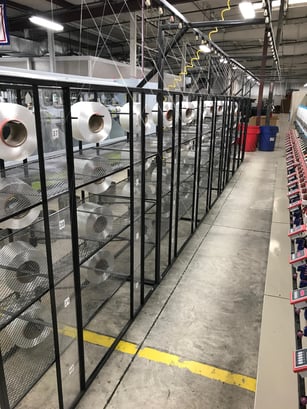 A creel is simply a frame on which the feeding thread or yarn bobbin is fitted. Often, the creel is fitted with a yarn tensioning device which controls tension variation. Proper placement and stabilization of thread and yarn at the beginning of the product manufacturing process is critical. “Think of a creel as the foundation of a building,” states Neal Fournier, Facilities & Maintenance Manager with Service Thread. “It’s likely that process improvement starts after the yarn enters the production process; however, you will be surprised by the gains that can be made by taking a look at using a creel or refining your creel design.”
A creel is simply a frame on which the feeding thread or yarn bobbin is fitted. Often, the creel is fitted with a yarn tensioning device which controls tension variation. Proper placement and stabilization of thread and yarn at the beginning of the product manufacturing process is critical. “Think of a creel as the foundation of a building,” states Neal Fournier, Facilities & Maintenance Manager with Service Thread. “It’s likely that process improvement starts after the yarn enters the production process; however, you will be surprised by the gains that can be made by taking a look at using a creel or refining your creel design.”
How does a creel help control yarn tension?
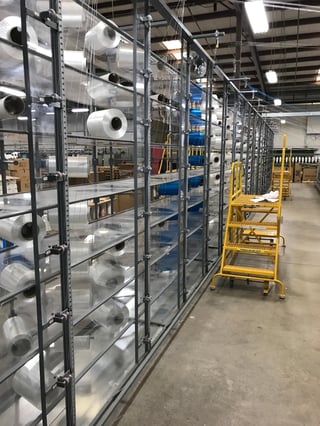 Creels allow for standardization of the yarn’s path and enable more accurate directional and tension control. Additionally, some high-tech creels provide automatic control, centralized tension variation, and yarn breakage monitoring systems. Evaluating creel design can have a tremendous impact on yarn joining methods that can be used as well as process efficiency because with the use of a creel, yarn tension control is more consistent with the result being less down time and less product defects.
Creels allow for standardization of the yarn’s path and enable more accurate directional and tension control. Additionally, some high-tech creels provide automatic control, centralized tension variation, and yarn breakage monitoring systems. Evaluating creel design can have a tremendous impact on yarn joining methods that can be used as well as process efficiency because with the use of a creel, yarn tension control is more consistent with the result being less down time and less product defects.
The most common type of creel is a simple pin that is usually a ½” to ¾” steel pin used for a variety of yarn or cone tube sizes. While this is a low cost, acceptable solution where different sized yarn packages are used, simple pins tend to allow a yarn package to pull off during the production process – causing breaks or interruptions in the yarn.
When you invest in the correct type of creel for your unique process, you will likely see an immediate reduction in scrap, and increased efficiencies. Whether your industry focuses on wire and cable (integration of ripcords), industrial bags (closures), fabrics and tarps, or hose reinforcement, here are 4 benefits you may see from implementing the use of a yarn creel for industrial applications:
1. Customized to the Size and Width You Need
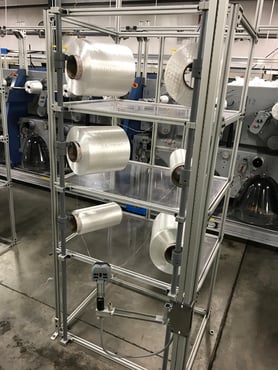 An important element in determining the best creel to fit your needs is identifying the type of base that best fits your production processes. Creel size is determined by floor space and capacity, which may limit options based on the manufacturing facility floorplan you are working within.
An important element in determining the best creel to fit your needs is identifying the type of base that best fits your production processes. Creel size is determined by floor space and capacity, which may limit options based on the manufacturing facility floorplan you are working within.
Most creel frames are designed simply to take the overall load, and the type of package holder is often overlooked. From simple pins to adjustable package adapters, fixed package creel adapters and roll-off adapters, it’s important to weigh the pros and cons of each.
2. Load Multiple Packages and Pigtail Together for Continuous Run
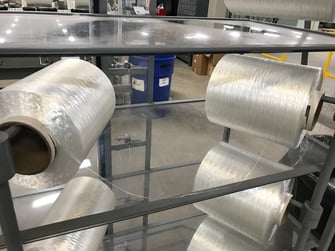 Specialty creels also allow for multiple yarn spools to be loaded for continuous run without stoppages during a production cycle. The transfer tail end of the running package is joined to the beginning of the reserve package, leaving no leftover material remaining on the bobbins after transfer. This type of creel will eliminate waste material and rewinding, and is typically used for high-volume, long runs or where it is critical that there are no line stoppages to replace yarn packages.
Specialty creels also allow for multiple yarn spools to be loaded for continuous run without stoppages during a production cycle. The transfer tail end of the running package is joined to the beginning of the reserve package, leaving no leftover material remaining on the bobbins after transfer. This type of creel will eliminate waste material and rewinding, and is typically used for high-volume, long runs or where it is critical that there are no line stoppages to replace yarn packages.
3. Defect Reduction
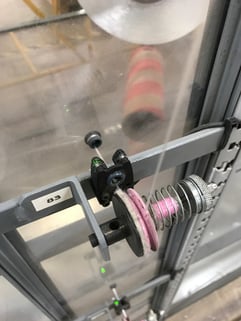 The prevention of and quick detection of defects are important factors in the manufacturing process. Yarn breakages or tension control issues can result in machine down-time and possible product rejection. Implementing a creel system will put a level of highly effective monitoring into place, enabling the use of end break detection and fault detection before the yarn ever makes it into your product.
The prevention of and quick detection of defects are important factors in the manufacturing process. Yarn breakages or tension control issues can result in machine down-time and possible product rejection. Implementing a creel system will put a level of highly effective monitoring into place, enabling the use of end break detection and fault detection before the yarn ever makes it into your product.
4. Tension Control and Uniform Yarn Path
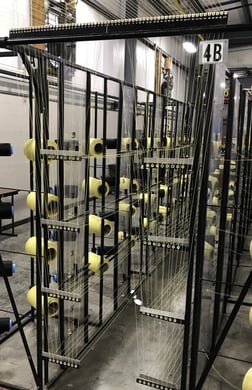 There are several mechanical and electronic tensioners that monitor and control the tension of yarn used in your production process. Choosing the best tension device depends heavily on knowing what is best for your yarn. Processing speeds, number of ends running, travel distance, desired tension range and other factors must be considered in order to make the best choice for your application. With a stationary creel, you know your yarn is always going to run in a uniform yarn path from the package location to the creel eyelets and on to your process.
There are several mechanical and electronic tensioners that monitor and control the tension of yarn used in your production process. Choosing the best tension device depends heavily on knowing what is best for your yarn. Processing speeds, number of ends running, travel distance, desired tension range and other factors must be considered in order to make the best choice for your application. With a stationary creel, you know your yarn is always going to run in a uniform yarn path from the package location to the creel eyelets and on to your process.
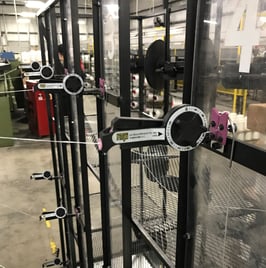 When was the last time you evaluated your process and assessed the best foundation for your yarn package? If you would like more control over yarn tension, yarn path and uninterrupted production runs, Service Thread can help customize and design the best industrial yarn creel for your unique application.
When was the last time you evaluated your process and assessed the best foundation for your yarn package? If you would like more control over yarn tension, yarn path and uninterrupted production runs, Service Thread can help customize and design the best industrial yarn creel for your unique application.



